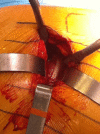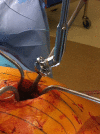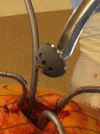Minimally invasive total hip arthroplasty using a transpiriformis approach: a preliminary report
- PMID: 22215476
- PMCID: PMC3392401
- DOI: 10.1007/s11999-011-2225-z
Minimally invasive total hip arthroplasty using a transpiriformis approach: a preliminary report
Abstract
Background: Continuing efforts have been made to develop minimally invasive surgery techniques for THA. One of the most commonly performed of these techniques is the mini-posterior approach. All reported series using this approach describe surgical detachment of the short external rotators of the hip. In 2008, Penenberg et al. described an innovative surgical technique that preserves the short external rotators. We present the results of a single-incision modification of this technique in 135 patients.
Description of technique: This technique is based on preservation of all of the short external rotators of the hip with the exception of the piriformis or conjoined tendon. This single-incision technique required the development of specialized instrumentation for exposure and reaming of the acetabulum. The specialized retractors also successfully minimized trauma to the skin and subcutaneous tissue.
Methods: For the 135 patients undergoing THA with this technique, we analyzed demographic and operative data. We recorded complications, evaluated postoperative clinical function using the Harris hip score, and assessed cup abduction angle, cup anteversion, and stem alignment on radiographs. Minimum followup was 14 months (mean, 22 months; range, 14-33 months).
Results: There were no dislocations, no sciatic nerve palsies, no wound complications, and low transfusion rates (8%). The postoperative Harris hip score averaged 96.5 (range, 87-100). Overall acetabular cup abduction angle averaged 41° (range, 21°-49°) and anteversion averaged 21° (range, 15°-27°). Four percent and 2% of femoral components were inserted into more than 2° varus and 2° valgus alignment, respectively.
Conclusions: This technique shows promise as an alternative tissue-sparing method for minimally invasive THA.
Level of evidence: Level IV, therapeutic study. See Guidelines for Authors for a complete description of levels of evidence.
Figures








References
-
- Berry DJ, Berger RA, Callaghan JJ, Dorr LD, Duwelius PJ, Hartzband MA, Lieberman JR, Mears DC. Minimally invasive total hip arthroplasty: development, early results, and a critical analysis. J Bone Joint Surg Am. 2003;85:2235–2246. - PubMed
-
- Bierbaum BE, Callaghan JJ, Galante JO, Rubash HE, Tooms RE, Welch RB. An analysis of blood management in patients having a total hip or knee arthroplasty. J Bone Joint Surg Am. 1999;81:2–10. - PubMed
-
- Callanan MC, Jarrett B, Bragdon CR, Zurakowski D, Rubash HE, Freiberg AA, Malchau H. The John Charnley Award. Risk factors for cup malpositioning: quality improvement through a joint registry at a tertiary hospital. Clin Orthop Relat Res. 2011;469:319–329. doi: 10.1007/s11999-010-1487-1. - DOI - PMC - PubMed
MeSH terms
LinkOut - more resources
Full Text Sources
Medical
Research Materials

